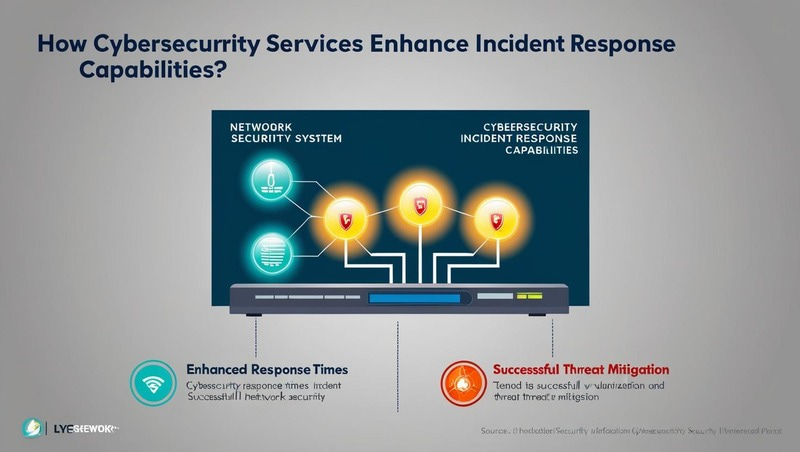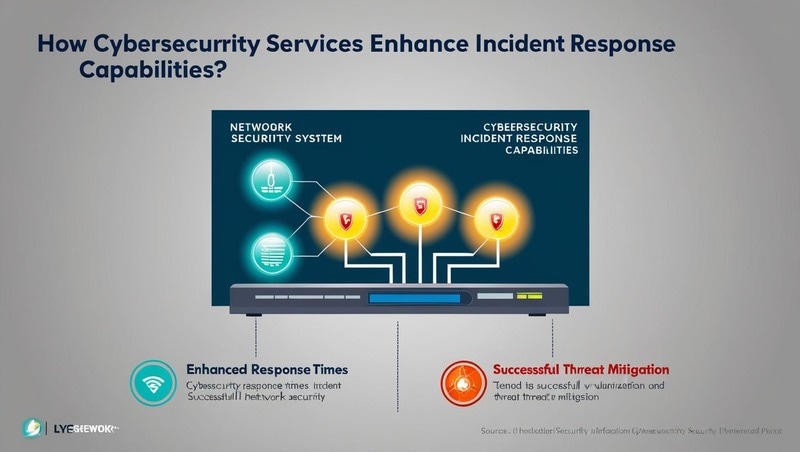Introduction
A cyber‑attack flips the ordinary workday on its head.
Phones light up, dashboards spike red, and every minute feels longer than the last. Yet the difference between a headline‑grabbing catastrophe and a manageable blip often comes down to preparation.
External teams providing IT cybersecurity services support bring not just tools but battle‑tested playbooks.
They help you spot trouble early, move with purpose once alarms sound, and close each incident with insights that sharpen the next response.
Detecting Incidents Before They Escalate

Setting up 24/7 threat monitoring for early detection
Around‑the‑clock monitoring replaces the “we’ll check in the morning” mindset with real‑time vigilance. Security analysts track logs, network flows, and cloud events while the office sleeps, ready to flag anomalies before they spiral.
Instead of relying solely on automated alerts, these experts interpret subtle patterns, unusual login geography, or odd data transfers that software alone might miss. Their human context bridges the gap between raw data and actionable signals.
Using behavioral analytics to spot suspicious activity in real time
Modern platforms learn what “normal” looks like inside your environment. When a privileged account starts downloading gigabytes at midnight or a seldom‑used port bursts to life, behavioral models light up instantly.
These statistical baselines evolve with your business. Seasonal workload spikes, new applications, and employee role changes feed fresh data into the model, keeping false alarms low while detecting true outliers fast.
Filtering false positives so teams focus on real threats
No one can chase every blip. Cybersecurity partners tune correlation rules and threat‑intel feeds, trimming noise that would otherwise drown internal staff.
By the time an alert reaches your on‑call engineer, it has already cleared multiple logic gates and human review. Response time improves because attention isn’t wasted on harmless anomalies.
Streamlining Investigation and Root Cause Analysis
Deploying forensic tools to trace how the attack occurred
Forensic agents snapshot volatile memory, preserve disk images, and map network conversations the moment an incident is confirmed. Rapid data capture freezes the crime scene before attackers wipe their tracks.
Specialists then dissect artifacts in a controlled lab, reconstructing command sequences, payloads, and exploited vulnerabilities. Knowing exactly how the breach unfolded guides precise remediation rather than blanket guesswork.
Identifying compromised systems, data access points, and attacker paths
Visual timelines show which accounts moved laterally, what data they touched, and how privileges escalated. This clarity prevents an overbroad shutdown that could stall legitimate business operations.
By isolating the exact blast radius, teams patch holes in days instead of weeks, sparing departments that were never impacted from unnecessary downtime.
Preserving logs and evidence for legal, regulatory, or internal review
Chain‑of‑custody procedures secure raw logs, chat histories, and email headers in tamper‑evident storage. If regulators or legal counsel come calling, the proof is intact and well‑organized.
Having admissible evidence readily available speeds insurance claims, supports law‑enforcement collaboration, and shows auditors the organization values transparency.
Coordinating a Rapid Response Across Teams
Activating predefined response playbooks for various incident types
Whether it’s ransomware or a stolen laptop, each scenario has a cookbook: isolate the host, notify legal, spin up clean infrastructure. Checklists cut hesitation and standardize actions across shifts and offices.
Playbooks are living documents. After every drill or real incident, teams adjust them, maybe a new contact sheet, maybe a refined containment step, so next time the path is even clearer.
Assigning roles clearly across IT, legal, PR, and compliance teams
Nothing stalls response like role confusion. Early in an incident, a roster clarifies who pulls firewall rules, who drafts customer notices, and who logs events for regulators.
Clear ownership prevents duplicated work and ensures no one overlooks a critical obligation like timely breach disclosures or evidence preservation.
Using centralized dashboards to keep stakeholders aligned
A single portal displays ticket status, containment progress, and affected assets in real time. Executives see high‑level impact, tech teams see granular task lists, and communications staff preview public statements, all without separate email threads.
Shared visibility reduces rumor loops and decision bottlenecks. Everyone operates from the same data, shortening war‑room meetings and accelerating sign‑offs.
Containing Threats with Minimal Disruption
Isolating infected endpoints or cloud environments instantly
Micro‑segmentation and software‑defined networks let defenders fence off a compromised workload with a few clicks. Traffic stops at the border while healthy systems keep humming.
This surgical containment beats wholesale shutdowns that cripple departments for hours. Users barely notice, yet attackers lose their foothold.
Applying automated shutdown protocols to halt lateral movement
Preconfigured response scripts disable rogue accounts, revoke tokens, and block command‑and‑control domains the moment specific indicators appear. Machines act in seconds faster than any human can.
Analysts then review automated steps, validating effectiveness and ensuring no critical service was collateral damage.
Redirecting traffic or services to backups while containment occurs
Hot‑standby servers and mirrored databases pick up the load, preserving customer‑facing uptime. Internally, staff continue using line‑of‑business apps without missing a beat.
By decoupling containment from availability, the organization meets SLAs and maintains trust, even during an active security event.
Recovering Systems Quickly and Safely
Restoring systems from secure, uncorrupted backups
Immutable backups, stored offline or in write‑once cloud vaults, replace compromised data sets. Automated orchestration repopulates servers, configurations, and application code in the right sequence.
Because backups are tested regularly, restoration windows are predictable. Leadership can tell stakeholders exactly when normal operations will resume.
Running post‑recovery scans to ensure no hidden threats remain
Freshly restored hosts undergo deep scans for backdoors, rootkits, or implanted scripts. Sandboxed detonation of suspicious files confirms that malware didn’t hitch a ride.
Only when scans come back clean does traffic fully reopen, preventing a “re‑infect on day one” scenario.
Verifying system integrity before returning to normal operations
Checksums and configuration baselines validate that recovered files match golden images. If discrepancies arise, like altered registry keys or unexpected binaries, analysts investigate before signing off.
This extra pass might seem slow, but it avoids the embarrassment of a second shutdown because something was missed in the rush.
Learning from Every Incident
Conducting post‑mortems to understand what went wrong
Debriefs pull together logs, timelines, and team reflections while memories are fresh. The goal isn’t blame; it’s clarity on root causes: outdated patch, lax MFA, missed alert.
Documented findings become case studies for the next tabletop exercise, ensuring lessons don’t fade when normalcy returns.
Updating response protocols and controls based on lessons learned
If an alert rule is too noisy, it gets refined. If a playbook missed a legal‑notice step, that gap closes. Continuous improvement transforms each incident into a catalyst for stronger defense.
Version‑controlled documentation keeps everyone on the latest procedures, eliminating tribal knowledge and outdated printouts.
Sharing anonymized insights across departments for broader awareness
A short, jargon‑free summary shows non‑IT teams what happened, why it mattered, and how they can help prevent a repeat. Everyone learns, culture strengthens, and silos shrink.
This transparency builds trust: staff see that leadership doesn’t hide incidents, and leadership sees staff embrace their role in security.
Meeting Regulatory and Legal Expectations
Documenting the full response timeline for audits and reporting
From first alert to final recovery, event logs and decision notes are timestamped and archived. Auditors can trace every action, showcasing deliberate, timely steps rather than ad‑hoc scrambling.
Clear timelines also help legal counsel defend against negligence claims, demonstrating the organization met or exceeded industry norms.
Notifying stakeholders within required disclosure timeframes
Regulations set the clock ticking after personal data is exposed. Cybersecurity advisors draft templates and communication flows in advance, ensuring notifications reach regulators, partners, and customers on schedule.
Prompt, transparent disclosure curtails rumors and often reduces penalties, as enforcement agencies favor organizations that act responsibly.
Demonstrating due diligence to minimize liability and penalties
When fines or lawsuits loom, proof of robust controls and swift response is a strong shield. External reports, threat‑intelligence subscriptions, and staff training logs all support the case that the organization took reasonable precautions.
Insurance carriers likewise view documented diligence favorably, potentially lowering premiums or speeding claim payouts.
Turning Incident Response into a Strategic Strength
Incidents will keep coming; no defense is flawless. What sets resilient organizations apart is the ability to detect early, investigate quickly, and recover cleanly. Cybersecurity services supply the expertise, automation, and coordination that turn a would‑be crisis into a controlled operation.
With every event analyzed and folded back into stronger playbooks, incident response evolves from frantic firefighting to a disciplined routine – one that protects revenue, reputation, and peace of mind.
Hackers don’t send warning notices. Every minute without proper protection is borrowed time. Devsinc’s 15+ years of security mastery stands between you and disaster. The question isn’t if you need better security. It’s whether you’ll get it before trouble strikes. Reach out to Devsinc today. Tomorrow might be one day too late.
